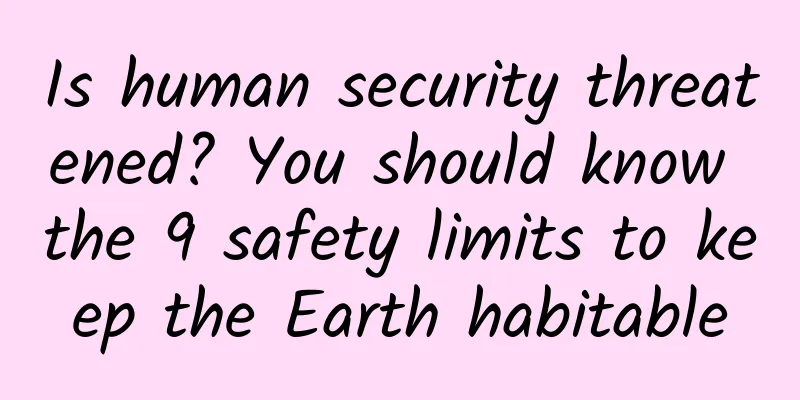Is human security threatened? You should know the 9 safety limits to keep the Earth habitable

|
Recently, Netflix in the United States released a very classic black satirical comedy, Don't Look Up, which tells the story of a huge meteorite that will destroy the earth in 6 months, and the different reactions of humans from different standpoints to it. In order to protect his own rights, the president actually tried to conceal the truth at the first opportunity; in order to mine the priceless rare materials on the meteorite, the bosses of the technology companies spent a lot of money to lobby officials to give up using missiles to change the orbit of the meteorite; the media, with the mentality of entertainment to death, broadcast the news as a joke; even the professor who originally discovered the meteorite eventually stood up for the technology boss for his own interests. As expected, the meteorite finally arrived on Earth 6 months later, wiping out the entire human civilization from the Earth. Interestingly, the director also claimed in the trailer that the drama was adapted from a real event, which might be the destruction of the earth's environment by humans. (Source: Pixabay) Recently, researchers from the Stockholm Environmental Resilience Center discovered that the chemical pollution produced by humans in recent years, including various pesticides, industrial waste, radioactive waste, antibiotics, etc., has exceeded the safety limits of the earth and broken the chemical balance of the earth over the past tens of thousands of years. It is reported that this is the fifth limit that humans have broken through the nine safety limits of the earth since the industrial revolution. In the future, when humans really break through all nine safety limits of the earth, perhaps it will end up like the ending of the movie, in a state of confusion, human civilization will be completely overturned. In this regard, Dr. Patricia Villarrubia-Gómez, research assistant at the Stockholm Environmental Regulation Centre, said, "Since 1950, human chemical production has increased 50 times and is expected to increase three times again by 2050. The Earth's ability to regulate these chemicals has already exceeded its limit, seriously threatening human safety." The study, titled “Outside the Safe Operating Space of the Planetary Boundary for Novel Entities,” was published in the latest issue of Environmental Science & Technology, a journal published by the American Chemical Society. 9 safety limits to keep Earth habitable For more than 12,000 years before the Industrial Revolution, the Earth's environment remained very stable. During this period, the overall temperature fluctuation did not exceed 1 degree Celsius, allowing humans and various wildlife to flourish. However, with the advent of the Industrial Revolution, in the past two centuries, people have continued to plunder the earth's resources and destroy the ecological environment, leading to a series of problems such as global warming and a sharp decline in biodiversity. In the mid-2000s, Dr. Johan Rockström, founder of the Stockholm Environmental Resilience Center, convened an international, interdisciplinary team to try to define a range of safe human activities on Earth so as not to exceed Earth's limits. Finally, in 2009, the center announced nine safety processes that are essential for the stability of the Earth's environment and the prosperity of human civilization: Climate Change: The increase in greenhouse gas concentrations in the atmosphere has led to a rise in global temperatures, and humans had already exceeded the safety limit of 350 ppm as early as 1980. But by 2020, carbon dioxide levels had reached 417 ppm. New compounds: Compared with climate change, new compounds are more difficult to capture and pose a serious threat to the earth's environment. New compounds include various harmful chemicals, materials such as plastics, and various heavy metals and radioactive substances released by human activities. Usually, the impact of these substances on the environment is unknown in the short term, but the long-term impact is very severe. For example, the global environmental pollution caused by plastics and the devastating impact of dichlorvos on biodiversity. Stratospheric ozone depletion: The depletion of stratospheric ozone caused by chemical pollution was first discovered in the 1980s, leading to the signing of the Montreal Protocol on Substances that Deplete the Ozone Layer in 1987. After decades of efforts, the ozone layer has shown signs of recovery. Atmospheric aerosols: Atmospheric aerosol pollution is an important threat to human health. For example, PM2.5 can cause a series of lung diseases. In addition, it also affects the air and ocean cycles of the climate. For example, severe aerosol pollution over the Indian subcontinent may cause the monsoon system to suddenly shift to a drier state. Ocean Acidification: Rising levels of carbon dioxide in the atmosphere are increasing the acidity of the world's oceans, posing a serious threat to marine biodiversity, especially invertebrates such as shells that dissolve easily in acidic waters. Earth's biochemical cycle: The large-scale use of fertilizers such as nitrogen and phosphorus has seriously interfered with the earth's natural nitrogen and phosphorus cycle, leading to imbalance in neighboring ecosystems. Fresh water use: Agriculture, industry and a growing global population are placing enormous pressure on the freshwater cycle, while climate change is altering global weather patterns, leading to polarization in droughts and floods. Land system changes: Land use, especially the conversion of tropical rainforests to cropland, is causing dramatic changes in Earth's climate due to its impacts on Earth's carbon dioxide concentrations, biodiversity, fresh water, and the reflectivity of the Earth's surface. Biosphere Integrity: The functional integrity of ecosystems is at the heart of Earth's security concerns, as they provide many ecological services, from pollination to clean air and water. Rapid declines in plant and animal populations, degradation of ecosystems, and loss of genetic diversity can wreak havoc on the integrity of Earth's biosphere. The stability of the above nine issues is crucial to maintaining the balance of the Earth's atmosphere, oceans and ecosystems, as well as the vigorous development of human civilization. In order to maintain the stability of the Earth's environment, researchers at the Stockholm Environmental Regulation Center evaluated the relationship between human activities and the global ecosystem and set a limit for each issue. Once the limit is broken, it means that the Earth may enter a state that has never been experienced before, threatening the survival of the entire human civilization. However, a series of studies from 2009 to 2015 found that four of the nine major safety limits for the survival of human civilization have been broken, including climate change, biodiversity, land system changes, and earth biochemical flows. The fifth limit has also been broken The happiness of modern human society is inseparable from the prosperity of artificial chemicals. Various chemicals, including plastics, pesticides, antibiotics, industrial chemicals, and consumer chemicals, have undoubtedly brought great convenience to human beings. However, with the continuous growth of global economic production and consumption, the total amount of various new compounds produced and discarded by humans is also rising rapidly. In this study, 14 scientists from the Stockholm Environmental Regulation Centre jointly found that human production of chemicals has increased 50 times since 1950 and is expected to increase three times again by 2050. (Source: Pixabay) It is conservatively estimated that there are approximately 350,000 different types of man-made chemicals on the global market. These substances created by humans that did not originally exist on Earth have an impact on the Earth's system environment far beyond people's cognition, and a large number of new chemicals enter the environment every year. Among these new chemicals, the production of the most familiar plastics alone increased by 79% between 2000 and 2015. The total mass of plastic on Earth is now more than twice the mass of all existing mammals, and 80% of the plastic ever produced has been abandoned in the Earth's environment. Studies have found that plastics can be found even in remote places such as the Arctic and Antarctic and even the Himalayan peaks. Plastics contain more than 10,000 other chemicals. During the natural degradation process, these chemicals will undergo complex chemical reactions, thus generating some new chemical pollution. The speed at which these new pollutants appear in the environment far exceeds the ability of humans to assess global or regional risks, causing serious damage to the earth's biodiversity and biochemical cycles. Ultimately, the researchers concluded that the current growing trend in the production and release of new chemicals poses a serious threat to the safety of the earth's environment, and we should take action to establish reasonable standards to reduce the production and release of chemical pollutants. Professor Patricia Villarubia-Gómez of the Stockholm Environmental Resilience Centre, one of the participants in this study, said: "It is necessary to vigorously develop a circular economy, which means that the current production processes of chemical materials and products need to be improved so that they can be reused instead of wasted. By designing recyclable chemicals and products, we can ensure that the impact of chemicals on the earth system is within a safe range and sustainable." References: https://pubs.acs.org/doi/10.1021/acs.est.1c04158# https://scitechdaily.com/earths-safe-planetary-boundary-for-pollutants-including-plastics-exceeded/ Academic headlines |
>>: January 2022 "Science" Rumor List: Do pre-prepared meals contain preservatives?
Recommend
YaYaYa! The 280th Danxia flyer turned out to be this one!
Danxia bird season is here, and the Guangdong Dan...
Localization wins the hearts of the people: A comprehensive analysis of the Chinese version of Sony PS4
Since Sony and Shanghai Oriental Pearl held a pre...
How do SEM bidders respond to company interview questions? A collection of interview secrets!
I believe that every SEMer works hard to optimize...
"Moore's Law" is coming to an end. Will photonic chips become the future of the electronics industry?
"The number of transistors integrated into a...
Baidu search CPC/eCPC/oCPC in one article
When promoting, many students often cannot distin...
Will a person be woken up by the urge to urinate during sleep? Will the bladder be ruptured by the urge to urinate?
Getting up every morning is a difficult thing for...
Google Waymo accuses Uber of stealing technology secrets in self-driving patent war
According to Reuters, on February 23rd local time...
Mingjun [Exchange Meeting] K-line thinking - the way of game
Mingjun [Exchange Meeting] K-line Thinking - The ...
The most searched! This ice cream doesn't melt even if it's left at 31℃ for an hour?
In recent days "Ice cream assassin" has...
Are shared bikes doomed to fail?
The closure of shared bikes has not slowed down pe...
Apple's Tim Cook: 2015 will be the year of Apple Pay
During Apple's first quarterly conference cal...
8 things you should know about Apple Watch before the launch
Apple watch Apple's Spring Forward conference...
Introduction to Qinggua Media’s intelligent advertising delivery system!
Introduction to Qinggua Media Intelligent Adverti...
Beyond the "black technology" of food, clothing, housing and transportation, textiles can also go to heaven and earth!
On February 22, the Long March 8 Yao-3 carrier ro...









